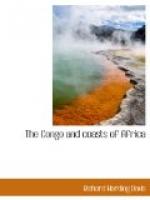People of the “Bromide” class who run across a friend from their own city in Paris will say, “Well, to think of meeting you here. How small the world is after all!” If they wish a better proof of how really small it is, how closely it is knit together, how the existence of one canning-house in Chicago supports twenty stores in Durban, they must follow, not the missionary or the explorers, not the punitive expeditions, but the man who wishes to buy, and the man who brings something to sell. Trade is what has brought the latitudes together and made the world the small department store it is, and forced one part of it to know and to depend upon the other.
The explorer tells you, “I was the first man to climb Kilamajaro.” “I was the first to cut a path from the shores of Lake Nyassa into the Congo Basin.” He even lectures about it, in front of a wet sheet in the light of a stereopticon, and because he has added some miles of territory to the known world, people buy his books and learned societies place initials after his distinguished name. But before his grandfather was born and long before he ever disturbed the waters of Nyassa the Phoenicians and Arabs and Portuguese and men of his own time and race had been there before him to buy ivory, both white and black, to exchange beads and brass bars and shaving-mirrors for the tusks of elephants, raw gold, copra, rubber, and the feathers of the ostrich. Statesmen will modestly say that a study of the map showed them how the course of empire must take its way into this or that undiscovered wilderness, and that in consequence, at their direction, armies marched to open these tracts which but for their prescience would have remained a desert. But that was not the real reason. A woman wanted three feathers to wear at Buckingham Palace, and to oblige her a few unimaginative traders, backed by a man who owned a tramp steamer, opened up the East Coast of Africa; another wanted a sealskin sacque, and fleets of ships faced floating ice under the Northern Lights. The bees of the Shire Riverway help to illuminate the cathedrals of St. Peters and Notre Dame, and back of Mozambique thousands of rubber-trees are being planted to-day, because, at the other end of the globe, people want tires for their automobiles; and because the fashionable ornament of the natives of Swaziland is, for no reason, no longer blue-glass beads, manufacturers of beads in Switzerland and Italy find themselves out of pocket by some thousands and thousands of pounds.




